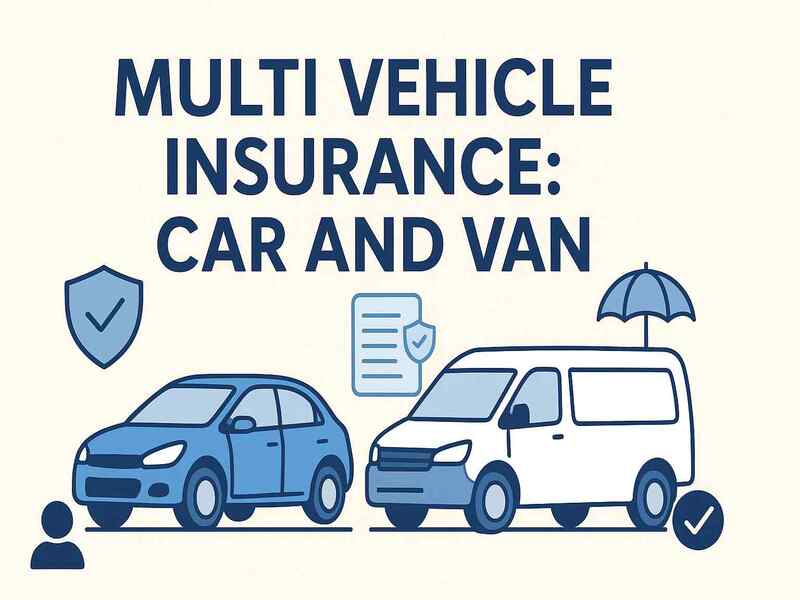Multi Vehicle Insurance Car and Van
Managing more than one vehicle can be expensive and complicated, especially when it comes to arranging insurance. Multi vehicle insurance car and van policies are designed to simplify the process while saving drivers money. Whether you are a family with multiple cars or a business owner with both a personal car and a work van, this type of insurance can be a cost-effective solution.
In this guide, we’ll explore what multi-vehicle insurance is, how it works, and why it may be the right choice for you.
What Is Multi Vehicle Insurance?
Multi vehicle insurance allows you to insure more than one vehicle under a single policy. This can include a car and van combination, two or more cars, or even a mix of cars, vans, and motorcycles.
Instead of managing separate policies for each vehicle, everything is covered under one umbrella. This makes renewal dates, paperwork, and payments much easier to handle.
Benefits of Multi Vehicle Insurance for Car and Van Owners
Simplified Administration
One of the biggest advantages of multi vehicle insurance is convenience. Instead of juggling multiple policies, you manage only one.
Potential Cost Savings
Insurers often provide discounts when multiple vehicles are insured under the same policy. These savings can be significant, especially if one of the vehicles has a higher premium.
Flexibility
Multi vehicle insurance typically allows different drivers and different levels of coverage across vehicles. For example, your car might have fully comprehensive cover, while your van might only need third-party coverage.
Who Can Benefit the Most?
Multi vehicle insurance car and van policies are ideal for:
-
Families with teenagers learning to drive.
-
Couples who own both a personal car and a van for work.
-
Small businesses that operate with a mix of vehicles.
By combining policies, these groups avoid the hassle of managing multiple renewal dates and benefit from discounts.
Key Features to Consider
When choosing a multi vehicle insurance car and van policy, keep the following in mind:
| Feature | Why It Matters |
|---|---|
| Discounts | Multi-car discounts can reduce premiums significantly. |
| Different Cover Levels | Allows each vehicle to have tailored coverage. |
| Named Drivers | Ensure all drivers are correctly listed to avoid invalid claims. |
| No-Claims Bonus Protection | Some insurers let each vehicle keep its own no-claims bonus separately. |
| Breakdown Cover | Can sometimes be extended across all vehicles in the policy. |
Cost Comparison: Multi Vehicle vs. Separate Policies
Many drivers wonder if a multi vehicle insurance car and van policy is always cheaper. The truth is, it depends.
-
If both vehicles are low-risk and inexpensive to insure, separate policies might occasionally be cheaper.
-
If one vehicle is high-risk (e.g., a commercial van), combining it with a safer, low-risk car can balance the overall cost.
-
Family discounts and loyalty rewards can further reduce premiums on a multi vehicle plan.
Common Misconceptions
"I Need to Start Both Policies at the Same Time"
Not true. Most insurers allow you to add vehicles to a multi vehicle policy as they come up for renewal.
"My No-Claims Bonus Will Be Shared"
In most cases, each vehicle maintains its own no-claims bonus. That means an accident with your van won’t affect the discount you’ve built up on your car.
"It’s Only for Families"
While families benefit the most, business owners and even individuals with two vehicles can take advantage of multi vehicle insurance.
How to Find the Best Policy
Shop Around
Always compare quotes from multiple providers before committing.
Check for Hidden Fees
Some insurers may charge admin fees for changes mid-policy.
Consider Usage
A van used for commercial purposes may need different coverage compared to a private car.
Use Comparison Tools
Websites such as insurance comparison platforms can make it easier to see which insurers offer the best deals.
Practical Example: Car and Van Coverage
Imagine a self-employed electrician who owns:
-
A personal car for commuting and family use.
-
A work van used for transporting tools and equipment.
By using a multi vehicle insurance car and van policy:
-
The electrician gets a discount for combining both vehicles.
-
Each vehicle has different cover (the van has business use coverage, the car has personal use).
-
There’s only one renewal date and one monthly payment.
This setup not only saves money but also simplifies administration.
Tips for Reducing Costs Further
-
Increase Voluntary Excess: Higher excess usually means lower premiums.
-
Improve Security: Installing alarms, immobilisers, or tracking devices can reduce the risk for insurers.
-
Low Mileage Discounts: Some insurers offer reduced rates if your car or van is not driven frequently.
-
Bundle Extras: Adding breakdown cover or legal protection across all vehicles can be cheaper than buying separately.
The Future of Multi Vehicle Insurance
With the rise of electric vehicles and flexible car ownership models, multi vehicle insurance is likely to become even more popular. Insurers are adapting policies to cover electric vans, shared ownership vehicles, and even subscription-based car models.
As technology evolves, policies may also integrate telematics (black box insurance) to offer tailored discounts for safe driving across all vehicles.
Conclusion
A multi vehicle insurance car and van policy is an excellent option for families, couples, and small business owners who want to simplify their insurance management and save money. While it may not always be the cheapest option, the convenience, flexibility, and potential discounts make it a smart choice for many drivers.
By comparing providers, tailoring cover to each vehicle, and using cost-saving strategies, you can ensure that both your car and van are protected without breaking the bank.


